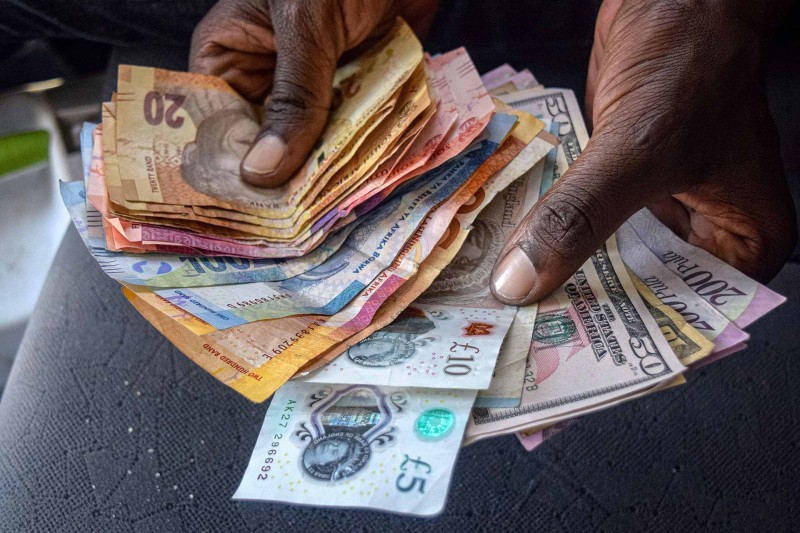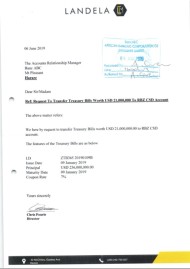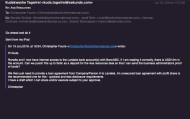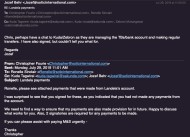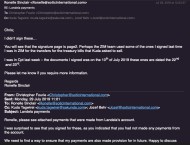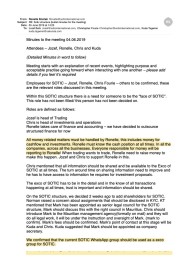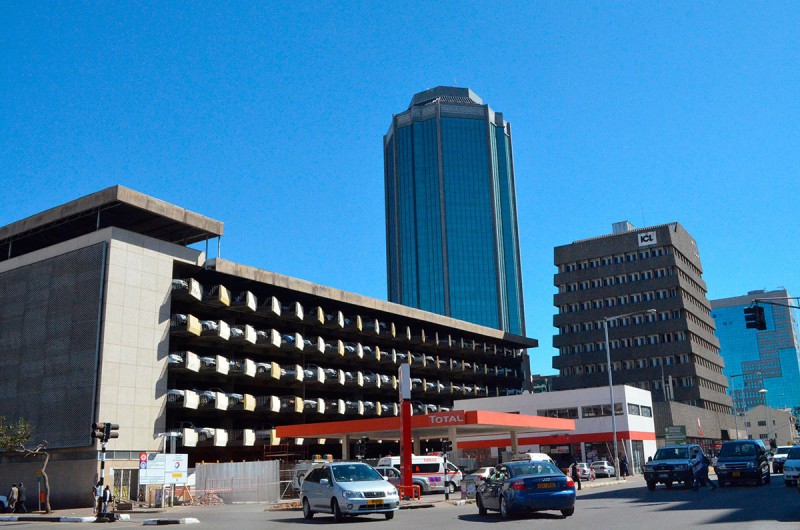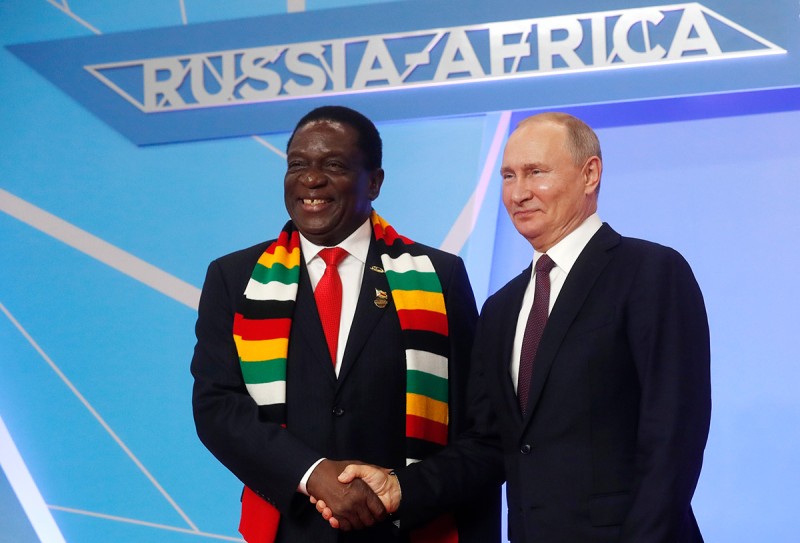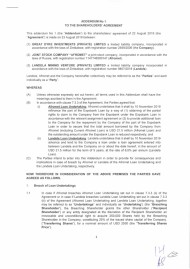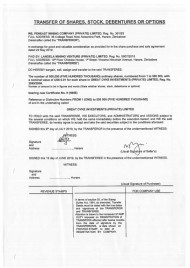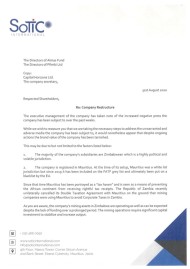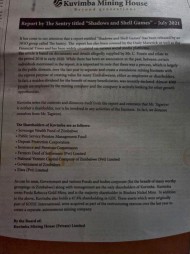As allegations of economic crimes swirled around Zimbabwean tycoon Kudakwashe Tagwirei in early 2020, his business associates were worried that foreign authorities were planning to take action against him.
Christopher Fourie, a central figure in Tagwirei’s corporate network, sent a WhatsApp message in April 2020 to a colleague asking for details of a “contingency plan” in the event Tagwirei “gets sanctioned by [the] U.S.”
Just four months later, this possibility became a reality when the U.S. slapped sanctions on the fuel magnate for misusing huge amounts of public money intended to boost the country’s farming sector.
Specifically, the U.S. Treasury Department said Tagwirei had used his “relationship with President [Emmerson] Mnangagwa to grow his business empire dramatically and rake in millions of U.S. dollars.”
Access to U.S. dollars has long been important in Zimbabwe, where domestic currencies have suffered chronic hyperinflation. Matters took on added urgency in early 2019, when Mnangagwa introduced a new pseudo-currency, the Real Time Gross Settlement dollar, or RTGS. The decision cut off most access to U.S. dollars for Zimbabweans, apart from the government and central bank.
Yet evidence suggests that these restrictions did not extend to Tagwirei, who is known to be close to Mnangagwa and other key Zimbabwean officials, including the head of the central bank.
Documents obtained by OCCRP show that the same month the RTGS was made Zimbabwe’s official currency, Tagwirei acted swiftly to extract U.S. dollars from a government security his company had been awarded. These securities, known as treasury bills, should have only paid out upon maturity, but Tagwirei was permitted to cash them out ahead of time.
This preferential treatment let Tagwirei avoid the probability that his treasury bill would be worth only a fraction of its face value when it matured.
The impending collapse of RTGS was clear; even the Zimbabwean government admitted it. “Since its adoption, the RTGS Dollar has continuously lost value at … 1 percent per day,” the Minister of Finance and Economic Development said. “Devaluation has been accompanied by rampant inflation.”
As Zimbabwe’s new currency floundered, Tagwirei used the tens of millions of U.S. dollars he was grabbing to fund the acquisition of a key mining project by his company Landela Mining Ventures (Pvt) Ltd, a subsidiary of his holding company Sotic International that was set up in Mauritius in February 2019, the same month the RTGS was launched.
“The whole point of Landela was to get the treasury bills money out of Zimbabwe and into Sotic, where it was used for the acquisition of Zimbabwe’s biggest mines and minerals,” Fourie, the insider who has since left Tagwirei’s team, told OCCRP.
By accumulating scarce U.S. dollars, Tagwirei’s companies exacerbated the country’s economic problems.
“There were only so many dollars in the country and they mopped it up by cheating,” Zimbabwe’s former Finance Minister Tendai Biti told OCCRP.
As the initially overvalued pseudo-currency began to lose value, Tagwirei’s team tried to extract more dollars, but as they did, experts said they undermined the RTGS and caused the currency to crash faster.
In a September 2019 statement, the International Monetary Fund suggested that giving certain people preferential access to U.S. dollars — which the Fund diplomatically referred to as a "continuation of [foreign exchange] market distortions" — had been a key pressure on the new RTGS currency.
Biti, who is now a member of Zimbabwe’s parliament, said the liquidation of treasury bills by Tagwirei had directly contributed to the crash of the new pseudo-currency.
The risk posed by allowing Tagwirei to cash in his treasury bills for U.S. dollars was evident long before 2019. In December 2017, Patrick Chinamasa, the acting Finance Minister at the time, told Zimbabwe’s parliament that inflation was being exacerbated by a shortage of U.S. dollars partly caused by issuing and paying out on treasury bills.
Tagwirei denied any wrongdoing, but did not respond to specific questions on the currency scheme sent by OCCRP.
Taking From the Treasury
Treasury Bills
In Zimbabwe, Tagwirei has such a strong influence on the country’s economy that he is known as Queen Bee. Before he was sanctioned, and as the prospect of a new currency drew nearer, he had overseen a years-long scheme to accumulate U.S. dollars.
High debt levels from 2012 to 2019 had caused the Zimbabwean government to stop issuing treasury bills to the public. Despite this, between 2016 and 2019 Tagwirei’s company Sakunda obtained billions of dollars in treasury bills through its role in a government agricultural project, which experts say has been a failure.
The treasury bills, handed to Sakunda for free and without proper government approval, were not meant to be cashed out but were instead ostensibly to function as insurance for the company’s spending on the agriculture project. Sakunda had been selected by the government as the only private sector partner for the project, following a secretive no-bid tender.
Until early 2019, treasury bills — including those granted to Tagwirei’s companies — were denominated in U.S. dollars. However, in February 2019 President Mnangagwa’s government introduced the RTGS currency. A controversial piece of legislation allowed the government to convert all debt and balances from U.S. dollars to RTGS at a 1:1 rate — even though the RTGS was far less stable than the dollar and its value was falling fast.
Zimbabwe’s Pseudo “Electronic” Currency
Though securities such as treasury bills were also supposed to be issued in or converted into RTGS, Tagwirei managed to skirt the new law.
“This law said one dollar for one RTGS,” Biti said. “If you bought a $100 million treasury bill, after February 2019 everyone other than Tagwirei would get 100 million RTGS only.”
Biti’s suggestion that Tagwirei received special treatment is backed up by internal correspondence obtained by OCCRP showing Tagwirei’s staff liquidating treasury bills early, and converting them to U.S. dollars rather than RTGS . They ultimately managed to extract $60 million U.S. dollars from a security that should have been worth just $15 million if it had been converted into RTGS on its maturity date.
In early June 2019, Fourie, who was then the director of Landala, wrote to John Mangudya, governor of Zimbabwe’s central bank, asking for the liquidation of more than 334 million RTGS from its $256 million treasury bill.
One of the letters from Fourie requested the liquidation of 115,783,500 RTGS, which, at the interbank exchange rate of the day (5.5135 RTGS to one U.S. dollar), translated to exactly $21 million. The letter’s justification for wanting access to this cash was vague, saying only that the funds would be used for buses, fertilizer and to make a payment to a mining company.
The request was sent alongside an almost identical letter asking for the liquidation of a further $39.7 million from the same treasury bill.
The premise for the request was that Landala supposedly needed to pay invoices. However, internal emails obtained by OCCRP show Tagwirei’s staff appear to have fabricated these invoices in order to access U.S. currency. The amount of RTGS invoiced appeared to be based on how many U.S. dollars the team wanted and what the exchange rate of the day was.
According to Zimbabwean law, Landela should not have been able to monetize any of its treasury bill before maturity. Even if this were permitted, the company received far more in U.S. dollars than the bill was worth. The bill should have been converted to RTGS by June 2019, and 256 million RTGS were worth no more than $46.5 million.
Zimbabwe’s Central Bank, which approved the liquidation of Landela’s treasury bills, dominates the skyline in the country’s capital, Harare.
Nonetheless the request was approved by Zimbabwe’s central bank. Mangudya, the bank governor who had to sign off on the request, is listed in documents and emails as a key figure in the trusts behind Tagwirei’s offshore business empire, though he has denied being a part of the trust structures.
“If Tagwirei got U.S. dollars in June [2019] or got approval for it, it is fraud,” said Biti.
No Preferential Treatment For Zimbabwean Miners
Having obtained approval for the transaction from Zimbabwe’s central bank, Fourie then wrote to Landela’s bankers at Banc ABC, who in turn requested the transfer of the agreed U.S. dollar values from the central bank account.
However, Fourie’s letters to Banc ABC, obtained by reporters, feature two significant irregularities: Banc ABC stamped the documents on June 4, two days before the letters were dated, and the maturity date of the treasury bill had been backdated by a year, to January 2019 instead of the correct date in January 2020.
It is unclear when all of the U.S. dollars requested in these letters were finally disbursed to Landela, but an internal company document suggests it was done by January 9, 2020, the date of maturity of the treasury bills.
In September 2019, just a few months after the Landela letters, the Financial Times in the U.K. reported that the International Monetary Fund had privately warned Zimbabwe’s government about the economic impact of its dollar payments to Tagwirei.
Zimbabwe’s Central Bank governor Mangudya told OCCRP that questions about Tagwirei’s treasury bills should be sent to the government: “The treasury bills issued by the Government to Sakunda for the Command Agriculture [were for] a Government program and not a Central Bank program.”
Neither the Minister of Finance nor Banc ABC responded to requests for comment.
Going Platinum
Tagwirei’s companies had access to other treasury bills beyond the one referenced in the June 2019 letters, though it is unclear exactly how many. Internal emails obtained by OCCRP indicate treasury bills were used by Tagwirei’s staff often, whenever they needed money.
The correspondence suggests Tagwirei used the Landela account specifically to manage treasury bills. The U.S. dollars would then be moved from Landela to Sotic International, Fourie told reporters. To help make the flow of dollars appear legitimate, loan agreements between the companies were set up.
On at least one occasion, Tagwirei also appeared to personally profit from Landela. The company transferred $1.5 million to Tagwirei in May 2020, according to a bank withdrawal request obtained by OCCRP.
In addition, correspondence suggests that Tagwirei used his influx of U.S. dollars to buy into the natural resources sector. The sale of treasury bills was discussed internally around the middle of 2019, just as Landela was taking steps to acquire a major platinum mining asset in Zimbabwe.
In May 2019 Landela struck a deal with state-owned Pen East Mining Company (Pvt) Ltd, which was led by former Zimbabwean military figures, to buy out its shares in a promising platinum project. Pen East owned half of Great Dyke Investments (GDI), a joint venture with Afromet, a subsidiary of Russian billionaire Vitaly Machitski's VI Holding. GDI owned rights to Darwendale, one of the world's largest platinum reserves.
Platinum-Plated Opportunity
Landela purchased Pen East’s shares for $220 million, according to July 2019 letters of comfort written by Tagwirei’s lawyer on behalf of Zimbabwe's Ministry of Mines and Ministry of Finance. Under the terms of the deal, Landela was also asked by Pen East to pay 46 million RTGS — equivalent to $11 million, according to the letter — in taxes on behalf of the company, according to emails. This sum was to be paid by Tagwirei, in addition to the $220 million, according to Fourie, in an agreement the former employee described as "off the books."
One of the June 2019 Landela letters to the central bank requesting liquidation of part of the $256 million treasury bill said the company needed some of the money for a payment to Pen East for its GDI shares. Landela said it needed 46 million RTGS — the same amount it was supposed to pay to Pen East one month later.
Zimbabwean President Emmerson Mnangagwa, left, poses with Russian President Vladimir Putin at the 2019 Russia-Africa summit in Sochi, Russia.
Landela’s participation in the joint venture with VI Holding was contingent upon Landela providing GDI with a $21.5 million loan, but by late November 2019 the company had not yet done so, according to an email from Afromet representative Igor Higer to Landela’s Fourie. This suggests that the U.S. dollars had not yet been disbursed to the company. By the end of January 2020 — after the maturity of the treasury bill — Landela had made the payment and the company entered the joint venture.
Even as Pen East legally disposed of its shares in Darwendale, the military figures behind the company remained active in discussions about the mine. In an email to Tagwirei and his team, Colonel Siwinile Tauya, a former army officer, requested a briefing ahead of a 2019 meeting with GDI in Moscow and cited the need to “push for the interests of the Zimbabwean shareholder in the form of Landela.”
In July 2021, the U.K. followed Washington’s lead and sanctioned Tagwirei for corruption. Its official communication specifically noted Tagwirei’s use of treasury bills and “misappropriation of property.” By then, though, Tagwirei’s team had already begun to restructure his empire, moving Sotic-held mining assets including GDI into a new Zimbabwean entity called Kuvimba.
Platinum Shuffle
Despite claims by Kuvimba and Tagwirei to have nothing to do with each other, reports by Bloomberg, the Financial Times and U.S.-based advocacy group The Sentry last year highlighted their extensive connections.
Confidential internal communications obtained by OCCRP support these reports, showing how David Brown — at the time Sotic’s CEO — moved Sotic’s mining assets to a new Zimbabwean holding company, ZIWA, which became a shareholder in Kuvimba.
"To the extent that Kuvimba owns any of the entities through Sotic-created holding companies like ZIWA, it obtained them fraudulently and corruptly," said Fourie.
